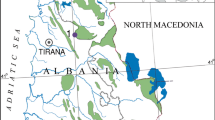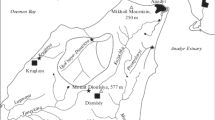Abstract
The article considers the theory, methods, and some results of four-year field studies of the processes of runoff formation on a small freezing experimental river catchment in a continuous thick (400 m) permafrost zone (the Republic of Sakha (Yakutia)) based on data on natural water chemistry. The analyzed problems include the seasonal and daily dynamics of river flow in the warm season, the concentrations of some dissolved substances in different types of water, as well as the role of channel widenings, supra-permafrost water, and aufeises in flow formation. Various types of relationships between water discharges and the concentrations of some dissolved substances are described under varying hydrothermal conditions. The role of nonfreezing lake-like channel widenings (bochags) in the regulation of freshet flow of water and dissolved matter is evaluated. The efficiency of the automated digital registration of the level, temperature, and specific electric conductance of water with a high time resolution at hydrological gages is discussed, especially, as applied to the rapid processes in a river.







Similar content being viewed by others
REFERENCES
Anisimova, N.P. and Pavlova, N.A., Gidrogeokhimicheskie issledovaniya kriolitozony Tsentral’noi Yakutii (Hydrogeochemical Studies of the Permafrost Zone in Central Yakutia), Novosibirsk: Geo, 2014. 189 s.
Boitsov, A.V., The formation conditions and the regime of slope taliks in the Central Yakutia, Kriogidrogeologicheskie issledovaniya (Cryohydrogeological Studies), Yakutsk: Inst. Merzlotovedeniya SO AN SSSR, 1985, pp. 44–55.
Varlamov, S.P., Skachkov, Yu.B., and Skryabin, P.N., The results of 35-year monitoring studies of cryolithozone at Chabyda Station (Central Yakutia), Nauka Obraz., 2017, no. 2, pp. 34–40.
Gusev, E.M., Nasonova, O.N., and Dzhogan, L.Ya., Scenario prediction of changes in water balance components in the Lena Basin in the context of possible climate changes, Water Resour., 2016, vol. 43, no. 5, pp. 754–765.
Ivanov, A.V., Kriogennaya metamorfizatsiya sostava prirodnykh l’dov, zamerzayushchikh i talykh vod (Cryogenic Metamorphization of the Composition of Natural Ice, Freezing, and Thawed Waters), Khabarovsk: Dal’nauka, 1998.
Kurakov, S.A., A system for autonomous monitoring of the environmental conditions, Datchiki Sist., 2012, vol. 4, no. 155, pp. 29–32.
Lebedeva, L.S., Bazhin, K.I., Khristoforov, I.I., Abramov, A.A., Pavlova, N.A., Efremov, V.S., Ogonerov, V.V., Tarbeeva, A.M., Fedorov, M.P., Nesterova, N.V., and Makar’eva, O.M., Supra-permafrost subaerial taliks in the Shestakovka R. basin (Central Yakutia), Kriosfera Zemli, 2019, vol. 23, no. 1, pp. 40–50.
Perel’man, A.N. and Kasimov, N.S., Geokhimiya landshafta (Landscape Geochemistry), Moscow: Astreya, 2000.
Slavinskaya, G.V. and Selemenev, V.F., Ful’vokisloty prirodnykh vod (Fulvic Acids in Natural Waters), Voronezh: Voronezhskii Univ., 2001.
Tarbeeva, A.M., Lebedeva, L.S., Efremov, V.S., Krylenko, I.V., Surkov, V.V., Shamov, V.V., and Lutsenko, T.N., The conditions and processes of formation of the beaded channel of a small river in cryolithozone: case study of the Shestakovka R., Central Yakutia, Kriosfera Zemli, 2019, vol. 23, no. 2, pp. 38–49.
Filippov, V.E. and Vasil’ev, I.S., Periglacial relief of the Lena–Vilyui interfluve, Geogr. Prir. Resur., 2006, no. 4, pp. 82–86.
Shepelev, V.V., Nadmerzlotnye vody kriolitozony (Supra-Permafrost Water of Cryolithozone), Novosibirsk: GEO, 2011.
Bieroza, M. and Heathwaite, A., Seasonal variations in phosphorus concentration–discharge hysteresis inferred from high-frequency in situ monitoring, J. Hydrol., 2015, vol. 524, pp. 333–347.
Bring, A., Shiklomanov, A., and Lammers, R.B., Pan-arctic river discharge: prioritizing monitoring of future climate change hot spots, Earth’s Future, 2017, vol. 5, pp. 72–92.
Brown, K.A., Williams, W.J., Carmack, E.C., Fiske, G., Francois, R., McLennan, D., and Peucker-Ehrenbrink, B., Geochemistry of small Canadian Arctic rivers with diverse geological and hydrological settings, J. Geophys. Res.: Cryogeosci., 2020, vol. 125. e2019JG005414. https://doi.org/10.1029/2019JG005414
Cartwright, I., Morgenstern, U., and Hofmann, H., Concentration versus streamflow trends of major ions and tritium in headwater streams as indicators of changing water stores, Hydrol. Process., 2020, vol. 34, pp. 485–505. https://doi.org/10.1002/hyp.13600
Clow, D.W. and Drever, J., Weathering rates as a function of flow through an alpine soil, Chem. Geol., 1996, vol. 132, pp. 131–141. https://doi.org/10.1016/S0009-2541(96)00048-4
Creed, I.F., McKnight, D.M., Pellerin, B.A., Green, M.B., Bergamaschi, B.A., Aiken, G.R., Burns, D.A., Findlay, S.E.G., Shanley, J.B., Striegl, R.G., Aulenbach, B.T., Clow, D.W., Laudon, H., McGlynn, B.L., McGuire, K.J., Smith, R.A., and Stackpoole, S.M., The river as a chemostat: fresh perspectives on dissolved organic matter flowing down the river continuum, Can. J. Fish. Aquat. Sci., 2015, vol. 72, pp. 1272–1285. https://doi.org/10.1139/cjfas-2014-0400
Fabre, C., Sauvage, S., Noel, G.E., Teisserenc, R., Probst, J.L., Perez, J.M.S., and Tananaev, N., Assessment of sediment and organic carbon exports into the Arctic Ocean: the case of the Yenisei river basin, Water Res., 2019, vol. 158, pp. 118–135.
Georgiadi, A.G., Kashutina, E.A., and Milyukova, I.P., Long-term changes of water flow, water temperature and heat flux of the largest Siberian rivers, Polarforschung, 2017, vol. 87, no. 2, pp. 167–176.
Godsey, S.E., Kirchner, J.W., and Clow, D.W., Concentration–discharge relationships reflect chemostatic characteristics of US catchments, Hydrol. Process., 2009, vol. 23, pp. 1844–1864. https://doi.org/10.1002/hyp.7315
Gonzalez-Nicolas, A., Schwientek, M., Sinsbeck, M., and Nowak, W., Characterization of export regimes in concentration–discharge plots via an advanced time-series model and event-based sampling strategies, Water, 2021, vol. 13, no. 13, p. 1723. https://doi.org/10.3390/w13131723
Grimaldi, C., Grimaldi, M., Millet, A., Bariac, T., and Boulegue, J., Behaviour of chemical solutes during a storm in a rainforested headwater catchment, Hydrol. Process, 2004, vol. 18, pp. 93–106. https://doi.org/10.1002/hyp.1314
Hirst, C., Andersson, P.S., Kooijman, E., Schmitt, M., Kutscher, L., Maximov, T., and Morth, C.-M., D. Porcelli, Iron isotopes reveal the sources of Fe-bearing particles and colloids in the Lena River basin, Geochim. Cosmochim. Acta, 2020, vol. 269, pp. 678–692.
Keller, K., Blum, J.D., and Kling, G.W., Stream geochemistry as an indicator of increasing permafrost thaw depth in Antarctic watershed, Chem. Geol., 2010, vol. 273, pp. 76–81.
Knapp, J.L.A., von Freyberg, J., Studer, B., Kiewiet, L., and Kirchner, J.W., Concentration–discharge relationships vary among hydrological events, reflecting differences in event characteristics, Hydrol. Earth Syst. Sci., 2020, vol. 24, pp. 2561–2576. https://doi.org/10.5194/hess-24-2561-2020
Lloyd, C., Freer, J., Johnes, P., Coxon, G., and Collins, A., Discharge and nutrient uncertainty: implications for nutrient flux estimation in small streams, Hydrol. Process., 2016, vol. 30, pp. 135–152. https://doi.org/10.1002/hyp.10574
Rice, J.A. and MacCarthy, P., Statistical evaluation of the elemental composition of humic substances, Org. Geochem., 1991, vol. 17, no. 5, pp. 635–648.
Rode, M., Wade, A.J., Cohen, M.J., Hensley, R.T., Bowes, M.J., Kirchner, J.W., Arhonditsis, G.B., Jordan, P., Kronvang, B., Halliday, S.J., Skeffington, R.A., Rozemeijer, J.C., Aubert, A.H., Rinke, K., and Jomaa, S., Sensors in the stream: the high-frequency wave of the present, Environ. Sci. Technol., 2016, vol. 50, pp. 10 297−10 307. https://doi.org/10.1021/acs.est.6b02155
Shogren, A.J., Zarnetske, J.P., Abbott, B.W., Ianucci, F., Frei, R.J., Griffin, N.A., and Bowden, W.B., Revealing biogeochemical signatures of Arctic landscapes with river chemistry, Nature. Sci. Rep., 2019, vol. 9, p. 12 894. https://doi.org/10.1038/s41598-019-49296-6
Stuefer, S.L., Arp, C.D., Kane, D.L., and Liljedahl, A.K., Recent extreme runoff observations from coastal arctic watersheds in Alaska, Water Res. Res., 2017, vol. 53, pp. 9145–9163. https://doi.org/10.1002/2017WR020567
Tsyplenkov, A., Vanmaercke, M., Golosov, V., and Chalov, S., Suspended sediment budget and intra-event sediment dynamics of a small glaciated mountainous catchment in the Northern Caucasus, J. Soils Sedim., 2020, https://doi.org/10.1007/s11368-020-02633-z
Wild, B., Andersson, A., Broder, L., Vonk, J., Hugelius, G., McClelland, J.W., Song, W., Raymond, P.A., and Gustafsson, O., Rivers across the Siberian Arctic unearth the patterns of carbon release from thawing permafrost, Proc. Natl. Acad. Sci. USA, 2019, vol. 116, no. 21, pp. 10280–10285.
Zhi, W., Li, L., Dong, W., Brown, W., Kaye, J., Steefel, C., and Williams, K.H., Distinct source water chemistry shapes contrasting concentration–discharge patterns, Water Resour. Res., 2019, vol. 55, pp. 4233–4251. https://doi.org/10.1029/2018WR024257
ACKNOWLEDGMENTS
The authors are grateful to B.I. Gartsman (WPI RAS), V.V. Ogonerov, N.E. Baishev, N.V. Torgovkin, L.Yu. Boitsova, O.V. Shepeleva, N.I. Tananaev, and A.B. Kolesnikov (MPI SB RAS) for participation in the collection and processing of observation data.
Funding
The study was carried out as part of the work on the topic of state assignment No. 0272-2019-0027 (PGI FEB RAS), under the basic project of Research, Development and Technological Work No. 122012400106-7 (MPI SB RAS) and the basic project No. 121051100166-4 (Lomonosov MSU).
Author information
Authors and Affiliations
Corresponding author
Rights and permissions
About this article
Cite this article
Shamov, V.V., Lutsenko, T.N., Lebedeva, L.S. et al. Chemical Indication of the Processes of Freshet Runoff Formation in a Small Experimental Catchment in the Prilenskoe Plato, The Republic of Sakha (Yakutia). Water Resour 50, 379–391 (2023). https://doi.org/10.1134/S0097807823030120
Received:
Revised:
Accepted:
Published:
Issue Date:
DOI: https://doi.org/10.1134/S0097807823030120




